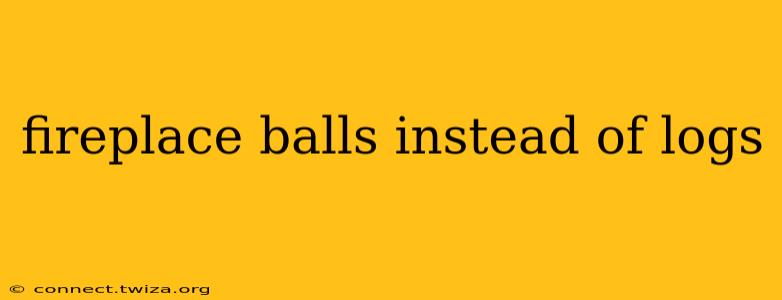Are you tired of the mess and hassle of traditional firewood? Have you considered using fireplace balls instead of logs as a heating alternative? This innovative approach offers a cleaner, more efficient, and potentially more convenient way to enjoy the ambiance of a crackling fire. Let's delve into the details of this intriguing alternative and explore its pros and cons.
What are Fireplace Balls?
Fireplace balls, also known as fire logs or fire starters, are essentially compressed fuel sources designed to burn more cleanly and efficiently than traditional wood logs. They often consist of various materials, including wax, sawdust, paraffin, and other combustible substances. These ingredients are carefully combined and molded into a ball-like or cylindrical shape, optimizing their burn time and heat output. While many are designed to be used as fire starters, some are substantial enough to provide significant heat for a considerable period.
Are Fireplace Balls Better Than Logs?
This is a nuanced question, and the answer depends heavily on individual priorities and circumstances. Let's break down the advantages and disadvantages:
Advantages of Fireplace Balls:
- Cleanliness: Fireplace balls generally produce less ash and creosote buildup than traditional wood logs, resulting in less cleaning and maintenance. This is a significant plus for those seeking a cleaner and more convenient heating option.
- Convenience: They are pre-packaged and ready to use, eliminating the need for chopping, stacking, and storing firewood. This is particularly appealing to those living in urban areas or lacking the space for storing large quantities of wood.
- Efficiency: Many fireplace balls are designed for consistent and efficient burning, often providing a more even heat distribution than wood. This means you might use fewer balls to achieve the same level of warmth as you would with wood logs.
- Consistent Burn: Unlike wood, which can burn unpredictably depending on its moisture content and type, fireplace balls offer a consistent burn time and heat output.
Disadvantages of Fireplace Balls:
- Cost: Fireplace balls can be more expensive per unit of heat than traditional firewood, especially if you source your wood locally.
- Environmental Impact: While some brands boast eco-friendly materials, others contain petroleum-based products. It's crucial to check the product's composition and look for sustainable and ethically sourced options.
- Smell and Scent: Some users find that fireplace balls produce a slightly different smell than wood. This might be a positive or a negative depending on personal preference; while some find the scent pleasant, others might find it artificial.
- Less Authentic Feel: For many, the crackling and scent of a real wood fire are integral to the experience. Fireplace balls don't quite replicate this authentic feeling.
What are the Different Types of Fireplace Balls?
The market offers a variety of fireplace balls, differing in size, burn time, and composition. Some are designed primarily as fire starters, while others are substantial enough to provide significant heat for extended periods. Always check the product specifications to ensure it meets your heating needs.
Are Fireplace Balls Safe to Use?
Generally, fireplace balls are safe to use when handled and used according to the manufacturer's instructions. However, always ensure adequate ventilation and never leave a burning fire unattended. As with any open flame, exercise caution and keep children and pets away.
How Long Do Fireplace Balls Burn?
The burn time of a fireplace ball varies greatly depending on its size and composition. Check the product packaging for specific burn time information. Generally, larger balls burn longer than smaller ones.
Where Can I Buy Fireplace Balls?
Fireplace balls are widely available at home improvement stores, hardware stores, and online retailers. Always compare prices and read reviews before purchasing to ensure you're getting a quality product that meets your needs.
This comprehensive guide should provide a thorough understanding of fireplace balls as an alternative to traditional wood logs. Remember to always prioritize safety and choose environmentally friendly options whenever possible.
